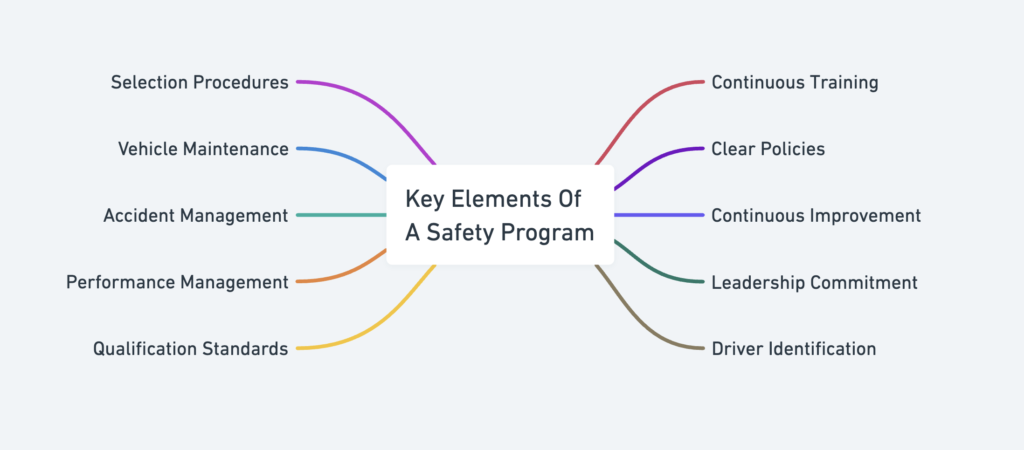10 Essential Elements for Creating a Successful Fleet Safety Program
The average fleet driver faces a 1 in 15 chance of getting into an accident annually, driving between 20,000 to 25,000 miles each year. With costs of accidents skyrocketing, businesses without a robust fleet safety program risk not only financial losses but also the safety of their employees.
A well-implemented fleet safety program is your shield against these risks. It doesn’t just cut costs; it enhances efficiency and boosts employee satisfaction. Let’s dive into the essential elements that make a fleet safety program successful.
Why a Fleet Safety Program is Critical
A fleet safety program isn’t a nice-to-have; it’s a must-have.
- Protects Employees: Your team’s safety is non-negotiable.
- Reduces Costs: Avoid high accident-related expenses.
- Boosts Productivity: Safe drivers are more efficient.

Steps to Building an Effective Fleet Safety Program
Start with a solid foundation. Here’s how:
- Establish a Fleet Safety Council: Form a team of key stakeholders.
- Gather Driver Feedback: Use their insights to improve policies.
- Proactive Communication: Keep everyone in the loop.
Key Elements of a Fleet Safety Program
1. Management Commitment
Your fleet safety program’s success hinges on leadership. Commitment from the top ensures the program is taken seriously and implemented effectively.
2. Identifying Drivers
Identify all of your employees who drive for business purposes, including those using personal and rented vehicles. This comprehensive approach covers all potential risks.
3. Screen and Select Drivers Carefully
Implement a rigorous screening process. Select drivers who demonstrate safe and reliable driving habits. This reduces liability and promotes a culture of safety.
4. Regularly Assess Your Driver Qualification Standards
Regularly assess your drivers to ensure they meet the required safety standards. Continuous qualification checks are essential for maintaining a high safety level.
5. Monitor and Manage Your Driver Performance
Consistently monitor and provide feedback to your drivers. Ongoing performance management keeps safety practices top of mind and improves driving habits.
6. Provide Continuous Safety Training
Ongoing education is crucial. Provide defensive driving courses and regular safety meetings to keep your drivers informed and prepared.
7. Establish Clear Policies and Procedures
Develop clear, written policies and procedures. Consistent guidelines set expectations and drive compliance across your fleet.
8. Perform Regular Vehicle Inspection and Maintenance
Regular inspections and maintenance prevent unexpected breakdowns and accidents. A well-maintained fleet is a safer fleet.
9. Have a Plan for Accident Management
Be prepared with an accident management plan. Quick and effective responses minimize costs and reduce the likelihood of future incidents.
10. Continuously Improve Your Safety Program
Regularly review and update your fleet safety program. Continuous improvement ensures your safety measures stay relevant and effective.


Benefits of Implementing a Fleet Safety Program
Implementing these elements brings numerous benefits:
- Accident Reduction: Fewer incidents mean fewer headaches.
- Improved Driver Behavior: Safer driving habits are cultivated.
- Enhanced Client Trust: Safety boosts your reputation.
- Better CSA Scores: Compliance is easier with a solid program.
Challenges and Solutions in Fleet Safety Programs
- Resistance to Change: Engage and educate your team.
- Budget Constraints: Prioritize essential elements first.
- Balancing Safety and Productivity: Safety should enhance, not hinder, productivity.
- Regulatory Compliance: Stay informed and compliant with regulations.
Tools and Technologies for Fleet Safety
Invest in Safety Solutions
Dash cams, telematics, and fleet management software are your allies.
Leverage Data
Use data for performance analysis and improvement.
Creating a Safety-First Culture
A safety-first culture is crucial. Engage employees in safety initiatives, and recognize and reward safe driving. Gamification can make safety fun and competitive.
Establishing Fleet Safety Benchmarks
Set clear, measurable goals. Use benchmarking to evaluate and improve performance.
A robust fleet safety program is essential. It protects your employees, reduces costs, and boosts efficiency. Start implementing these elements today to see real benefits.
Remember, the key to a successful fleet safety program lies in consistency, commitment, and continuous improvement. Don’t wait for an accident to highlight the need for a robust program.
For more insights on vehicle tracking and fleet management solutions, visit our vehicle tracking page.
Implement these elements today and make your fleet safer, more efficient, and more reliable.
Get started today, and protect your most valuable assets—your employees.
Frequently Asked Questions
- How can fleet safety solutions help combat distracted driving?
Fleet safety solutions like dash cams and driver monitoring systems can detect signs of distracted driving, such as eyes off the road or phone use. These systems provide real-time alerts and collect data for coaching opportunities. - How can a fleet safety program lower operational costs and insurance premiums?
By reducing accidents and improving driver behavior, a fleet safety program can lead to fewer claims and lower insurance premiums. Additionally, improved fuel efficiency and reduced maintenance costs contribute to overall operational savings. - How do dash cams contribute to a fleet safety program?
Dash cams provide visual evidence of incidents, exonerate drivers in not-at-fault accidents, and offer valuable footage for driver training. They also act as a deterrent for risky driving behaviors, contributing to an overall safer fleet.